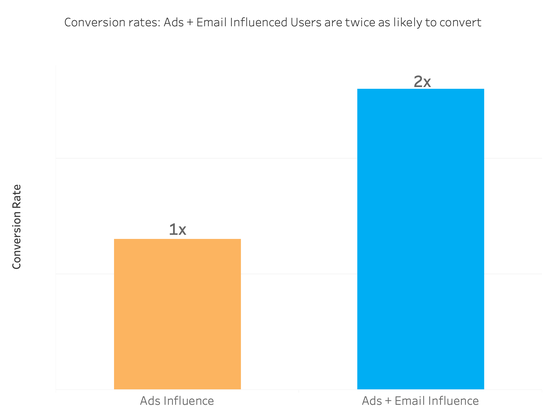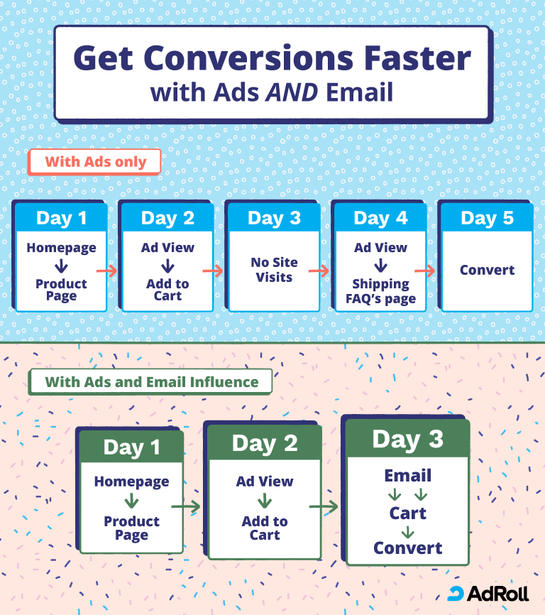Why AdRoll is Your Ideal Programmatic DSP
AdRoll helps you run full-funnel, multi-channel ad campaigns. Learn how our programmatic DSP enables better ad campaigns that convert customers.
Read More
If you’re a marketer, you probably know that it’s better to run multiple channels than one. But have you tested this assumption? Do you know the true impact of running emails and ads together? Since we launched our email product earlier this year, AdRoll’s client analytics and insights team has been closely monitoring performance to find the answer.
As part of our analysis, we considered two success metrics, conversion rate, and time to convert. We’re pleased to report that the results have been overwhelmingly positive. When we compared users who see both emails and ads to users who only see ads, here’s what we found on average:

Users who see emails and ads are twice as likely to convert. But wait, there’s more: after seeing that last ad or email, they purchase in half the time. Yes, you read that right — these users not only convert faster, but they’re also more likely to convert.
Nowadays, seeing ads alone isn’t enough — consumers are omnichannel, and they find companies’ services and products from a wide variety of people, places, and things. In fact, research has shown that customers require multiple touchpoints before converting.
While both tactics work fine on their own, by orchestrating emails and ads together with AdRoll, you can reach your audience in the right place at the right time.
With ads, you’re able to nurture your audience throughout the user journey before they’ve even heard of you. Add emails to the mix, and it takes you to a whole new level. Not only would you be coming at customers from all sides, but running emails in tandem with ads will also help to tell a cohesive and personalized story about your products and brand. All of this leads to more conversions, and shorter times to convert.
Here’s an example of a customer journey with ads vs. with ads and emails:

In the analysis, we segmented users into two groups: users that saw both email and ads and users that saw ads but no email. Then we calculated the conversion rate lift between these two user groups. Finally, we analyzed the distribution of this conversion rate lift across each of our customers that are running ads and email products. This allows us to control for any differences across our customers and isolate the differences between the user segments.
Why does this matter? Because every D2C marketer is unique. Some have high conversion rates and quick times to convert, while others have low conversion rates and long times from influence to conversion.
Furthermore, we made sure to remove any impact of loyalty campaigns that re-engage past converters. For the analysis, we only looked at conversions that happened after AdRoll influence (because conversion rates of converters is 100%).
So, what does this mean for this unprecedented holiday season? As you saw in our last chart of the month, CPMs increase substantially throughout the holidays due to increased demand for advertising and a relatively constant supply of inventory. What’s more, they have recovered since their lows in March and have caught up to the levels we saw in 2019. This shouldn’t scare you away, but it does mean you need to be strategic about where you invest and diversify your marketing tactics.
Last updated on January 31st, 2025.